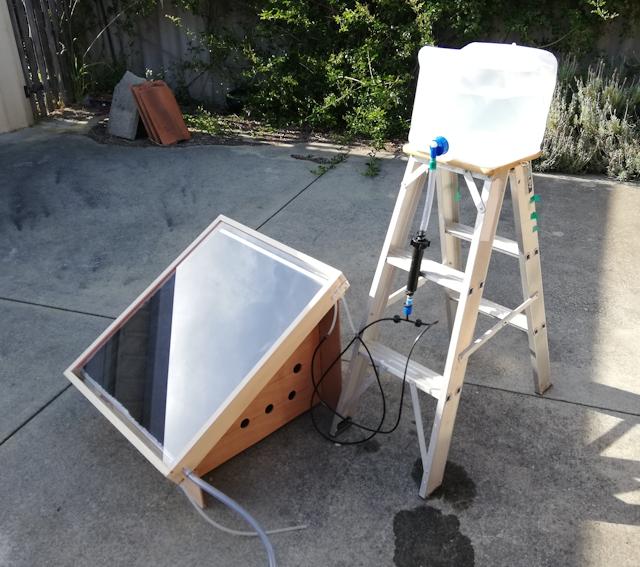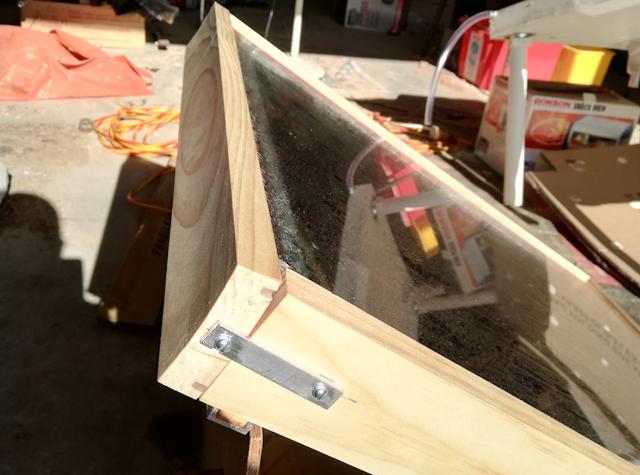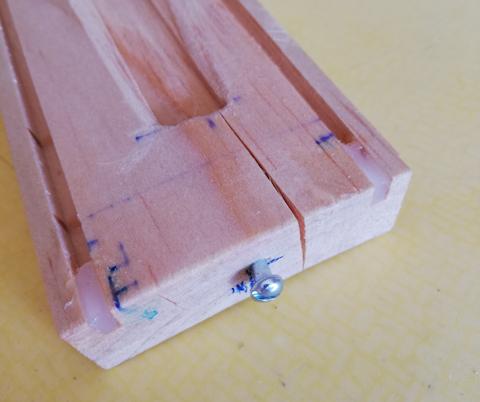Solar distiller prototype 4 first test
Today, November 7, 2019, in Perth, Western Australia, a sunny
day, mildly warm with prediction of 30 degC, slight breeze in the
morning, wispy clouds, a good day to test the solar water distiller
prototype #4. Previous blog posts have been construction details, last
post:
https://bkhome.org/news/201911/water-distiller-prototype-4-leg-assembly.html
I set it up at 7.35am. It is summer here in the Southern Hemisphere,
and the sun is already quite high in the sky. Some wispy clouds:

As the day progressed, the wispiness became less pronounced, but
there was a slight haze, so the sky was not quite the brilliant blue
that is typical of Aussie summers. Sun intensity quite high though. Here
is the setup:

Despite high hopes for the design of the distilled water runoff, the
runoff slope still is not right and the water didn't want to go into the
outlet tube. That needs more thought, but anyway, did manage to get the
distilled water to come out in one place. There was quite a long time
before any distilled water came out though...
Here is the report on test of prototype #3:
https://bkhome.org/news/201910/first-test-of-water-distiller-prototype-3.html
...which is essentially the same design, just some detail
differences. In that test, it took about 50 minutes for the inlet water
to trickle down the cloth to the bottom. However, in today's test, the
inlet water was connected at 7.35am, and it did not reach the bottom of
the cloth until 8.50am, a duration of 1 hour and 15 minutes. Waste water
started to come out of the outlet pipe at 9.00am.
Why did it take so much longer today, an extra 25 minutes. I think
that is because of lower water head. Although the water tank is the same
height as the previous test, it might seem as though the water head is
the same, however, it isn't. This might seem counter-intuitive, but the
water head depends on how much air is in the pipe from the container tap
down to the trickle flow reducers.
I discovered this problem back when I was designing the flow rate reducers:
https://bkhome.org/news/201906/testing-pope-4-litre-per-hour-dripper.html
For today's test, I didn't bother about getting the air out of the
pipe, and ended up with a slower flow rate. Which has turned out to be a
good thing. Today a very high distiller efficiency was achieved, which
may be due to the water flowing more slowly down the cloth, or maybe
part of the reason.
At 9.08am distilled water started to come out, and I started the measurements from that time.
At 9.30am, sun intensity was 830 W/m2, ambient was 24 degC,
temperature measured with an IR reader, held about three inches away
from the panel, about 3/4 from the top, was 44 degC front and 40 degC
back.
At 10.15, sun 930 W/m2, ambient 24 degC, front 52 degC, back 47 degC.
Note, the panel was oriented at a fixed position right from the start,
estimated to be facing the sun most directly at about 11am.
Ha ha, I have done it again! I went into the city by train, didn't
get back until 1.40pm, and the 450g pickle jar that was left to catch
distilled water had overflowed. Quite a bit, from the puddle. I had only
left a small jar there, as there wasn't much height. Besides, from
previous tests I only expected the jar to be approaching full in that
time duration.
1.40pm, sun 930 W/m2, ambient 27 degC, front 52 degC, back 50 degC.
Note, measuring the IR temperature at the top of the panel, about 2
inches away from the glass, measured 57.6 degC, and right at the bottom,
front, measured 42.7 degC. So, a good differential, ensuring the
circulating airflow.
Moved the panel to better face the sun -- this would probably not happen
in practice, but wanted to make up for the previous unknown water loss.
4.08pm, finished, as shade from patio had just reached the panel. Sun 870 W/m2, ambient 27 degC, front 48 degC, back 44 degC.
By this time, the panel is probably becoming less efficient, due to
loss of air sealing from the outside, as the wood has warped. More about
that below.
Anyway, the collection: 1.1 litres, in 7 hours. That is 157
millilitres/hour. The cloth has a surface area of 0.3327 m2, so to
compare efficiency with the F-Cubed panel which is 1 m2, need to scale
up: 157*(1/0.3327) which is 471.9 ml/hr. The F-Cubed panel gave 563.6
ml/hr, so today's test has a comparable efficiency of 83.7%.
It would actually be higher than that, due to the unknown amount
lost. And the problem of the wood warping. Very good, well on the way to
my survival goal of 1.5 litres per day.
Now the warping problem...
My lack of experience with the properties of wood has caught me out
here. I did think that the wood might swell slightly with the moisture,
but didn't expect that much, and so quickly. I had planned to treat the
wood with mineral oil, however, had not yet done so. I think though, the
oil would probably not have prevented the warping, just slowed it down.
So it was probably a good thing that I have seen the problem so soon.
Here is a photo, taken after 4pm:

Even worse, it has split:

Right, lesson learned. The design is good, excellent efficiency, with
further improvements in efficiency likely by tweaking type of cloth,
panel angle, type of glass, etc. Note, the glass is cheap "window
glass", which has a slight green tinge, that can be seen when looking at
the edge of the glass. This is due to iron in the glass. There is
low-iron glass available, more expensive. I don't know if it will make
an appreciable difference, but might test replacing the front panel with
low-iron glass.
Anyway, before trying those variations, the frame needs to be
constructed with some other material, perhaps polycarbonate. The
saga continues...
Tags: nomad
